
Project Summary:
The majority of the Philippine fringing reefs having gone from coral dominated to algae dominated systems. This is likely due to having herbivore populations greatly reduced due to their being collected as a human food source by over fishing. This leaves the undesirable, or inedible Diadema setosum remaining as the dominant herbivore. While the near shore habitats contain and hold a large population of juvenile Diadema species, the outer reef areas contain few adults. Such areas are under threat by Sargassum kelp which precludes coral recruitment and growth. This study will explore the feasibility and ecological results of translocating juvenile Diadema setosum from areas with relatively high settlement to nearby deeper water on fringing reefs. This is an individual effort performed by Charles Raabe with inspiration and guidance provided by Eric Borneman.
Objective(s):
The objective of this study is to increase the survival and local breeding population of Diadema setosum by removing vulnerable juveniles from their near shore habitats out into deeper water. With other herbivore populations having been artificially reduced by human activities, the naturally occurring movement of Diadema setosum to deeper water has not allowed large enough populations able to keep up with the algae control once performed by other herbivores. It is hoped that by translocating juveniles into the areas in need, the algae can be kept under control while allowing a greater number of juveniles to reach spawning age and accelerate the necessary population growth.
Methodology:
A kelp dominated rocky area located in deeper water will be selected to encompass a ten square meter area. All kelp cover will be removed. Once this area is cleared, thirty Diadema juveniles will be translocated and monitored on a weekly basis. In addition, another nearby ten square meter area will be selected and allowed to remain kelp covered and have the same number of Diadema juveniles placed within it. Each area will contain the necessary topographical complexity to provide shelter and reduce predation as well as being surrounded by sand or other barriers to impede migration out of the selected areas.
Evaluation:
On a weekly basis, both areas will be given a cursory inspection to note any possible problems. On a monthly basis, a detailed survey will be taken to count individual specimens within each area as well as documenting the effectiveness of each population. Each evaluation will try to include photographs to document any changes noted.
Study Areas:
Located on the eastern shore of Mactan Island, The Philippines. A fringing reef habitat containing extensive sea grass beds and shallow rock rubble, algae dominated areas, average depth is two meters. Beyond lays the coral fringing reef at an average depth of five meters.

Survey Results:
Area 1 - Kelp removed prior to the placement of thirty juvenile specimens.
Area 2 - Kelp left intact prior to the placement of thirty juvenile specimens.
Photographic details to provide a before and after view of each area, with close up photographs to document any remaining algae as well as the overall habitat.
Note: Both sites are within ten meters of each other.
Area : 1 (kelp removed)
Date: 26 March 2007
Notes: Site selection prior to kelp removal.
Photographs:
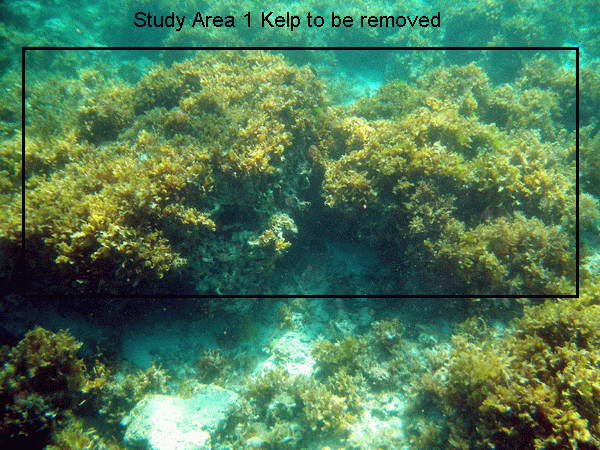
Area : 2 (kelp intact)
Date: 26 March 2007
Notes: Site selection
Photographs:
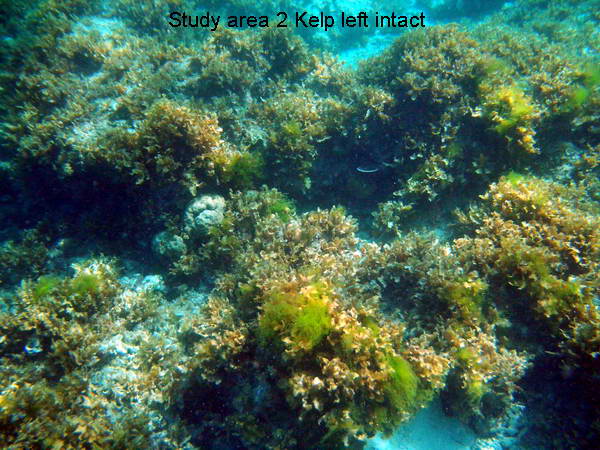
Area : 1 (kelp removed)
Date: 28 March 2007
Notes: Partial clearance of site and placement of 30 juvenile Diadema setosum, which were translocated from a nearby shallow sea grass bed. Individuals averaged 17cm in circumference.
Photographs:
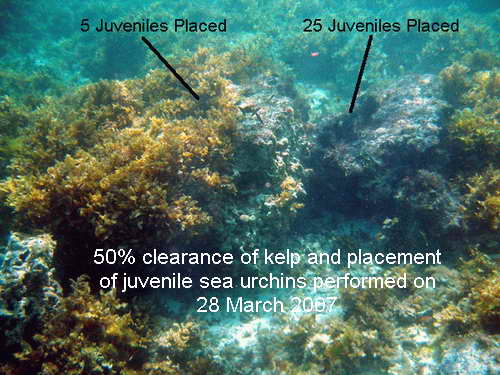
Area : 1 (kelp removed)
Date: 31 March 2007
Notes: Completed the removal of the remaining kelp. A population count was performed. Of the original thirty placed on 28 March. Fifteen remain within two feet of their original placement point and have moved as a group, to this areas highest point. Ten others remained within inches of their original placement. I found that five members of the original population had moved out of the study area onto a meter squared rock which is located midway between the two study areas, which were then recollected and returned to their original starting point within the study area. An inspection of the area that the main population had moved to revealed that they do appear to be cleaning that areas substrate of all algae matter, including the corallines.
Photographs:

Area : 2 (kelp intact)
Date: 31 March 2007
Notes: Placement of 30 juvenile Diadema setosum. A single specimen of another species was found in the study site and does not appear to be eating the kelp.
Photographs:
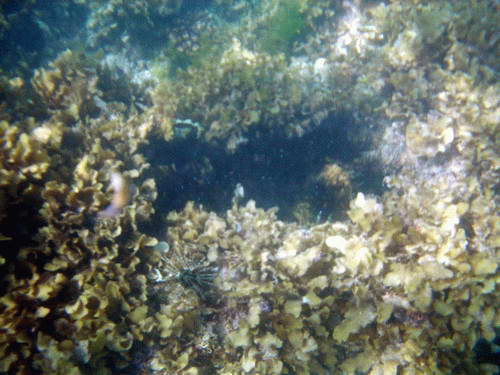
Area : 1 (kelp removed)
Date: 02 April 2007
Notes: Two groups of five urchins have left the site area and were found two meters away on much smaller isolated rocks. The remaining urchins (20) were found within sheltered areas either directly under the rock which forms a cave or they have taken shelter in suitably sized crevices. At this time I do have a concern if the remaining urchins will wander off the site as well. There appears to be a preference when moving, to do so in small groups. The availability of daytime shelter within a given area may determine local population densitys as such shelter seems to be the primary requirement.
Photographs:

Area : 2 (kelp intact)
Date: 02 April 2007
Notes: Half of the initial group has remained in the same location that they were initialy placed into. The other half have taken shelter within the sites crevices. They have also shown to be willing to consume the kelp as per the below photo.
Photographs:
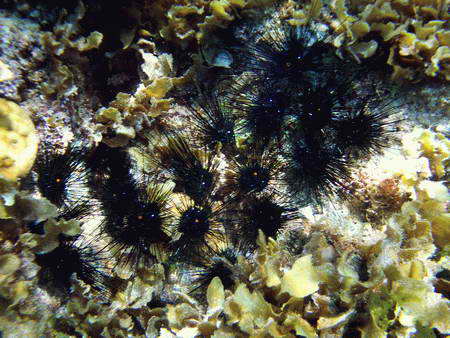
Area : 1 (kelp removed)
Date: 15 April 2007
Notes: Performed a survey today looking for any changes or sea urchin movement from the study site. Of the thirty placed within the site, I was able to locate 24 individuals. None of which were found on the top of the site area. Which I had expected, as the sea urchins take shelter during the daylight.
Photographs:
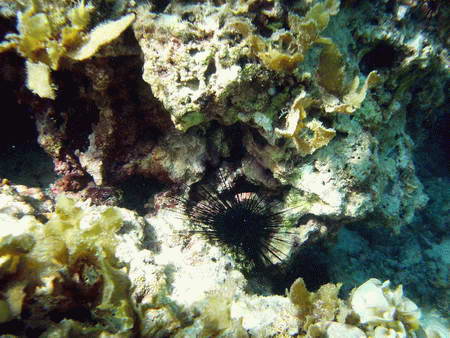
Area : 2 (kelp intact)
Date: 15 April 2007
Notes: Of the thirty placed within the site, I counted 32 individuals. I assume a few sea urchins from the other nearby site relocated. Again, all individuals were found in sheltered areas of the site. To date, I have good expectations, as the sea urchins do appear to be clearing all algae, including the kelp, from the immediate areas of their daytime shelter. I noted that the sea urchins, when originaly placed on the top of the site, have cleared the initial placement area of kelp and created a kelp free path as they made their way to more sheltered locations within the site.
Photographs:
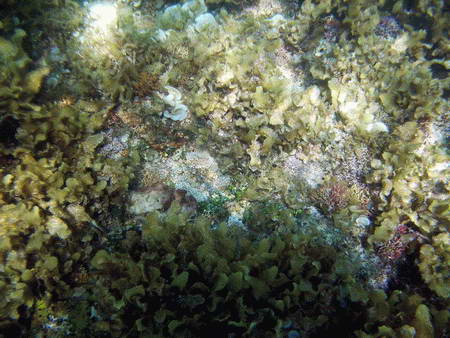
Area : 1 (kelp removed)
Date: 26 April 2007
Notes: As I had suspected, it appears that shelter is of great importance to the sea urchins as they appear to have spaced themselves out according to available crevices in which to take daytime shelter within. Each sea urchin appears to have staked out a specific sheltering location which it ventures out from at night to feed, eating the closest available algae and working its way outwards as it consumes its food sources nearest its shelter. I expect to see population densities thin out as the sea urchins consume readily available algae and are forced to spread themselves out amongst the habitat. As such, I will have to enlarge the study area to observe and document what the final densities become per available shelter and food sources.
Area : 2 (kelp intact)
Date: 26 April 2007
Notes: As noted earlier this month, the sea urchins appear to concentrating their grazing in the area nearest their daytime sheltering locations, which are located nearest the sea floor or under any overhanging ledges. These areas of course get grazed first. As the sea urchins deplete the nearest food sources, it is my hope that they will then venture onto the top most surface areas that recieve the most daylight and clear those areas, allowing coral recruitment to occur. In due time, I hope to be able to answer the question of wether hunger or safety will be the deciding factor in wether the upper substrates are cleared of algae or not.
Area : 1 (kelp removed)
Date: 10 May 2007
Notes: Since March 28th, those sea urchins that have remained within the study site have grown from an average cirumference of 17cm to over 30cm. As of today, I could only locate 12 of the original group noting the remainder have moved off of the study site into very nearby smaller rocky substrates, again, I have to assume that daytime shelter takes precedence over very nearby food sources. I also noted what appears to be some new coral growth, although I am unable to determine if this particular coral was already present and is just responding to the newly available light or if it had settled onto the newly algae free substrate recently.
Photographs:

Area : 2 (kelp intact)
Date: 10 May 2007
Notes: I was able to count only 16 of the original 30 placed within this area but continue to note an improvement in the reduction of the kelp cover. Just as Site 1, it appears that almost half of the originaly placed group has moved off of the site into nearby rocky shelters. Seeing that there is an overabundance of food sources, I can only conclude that available shelter will determine the final population densities. As such, I will have to continue to monitor the remaining population as to their ability to reduce and then control the invasive kelp.
Area : 1 (kelp removed)
Date: 30 May 2007
Notes: The weather cleared enough today to allow me back into the ocean. For the last three weeks, the passing storms have kept the surface water rough enough that I would not risk the lengthy swim out to the study site. It is at times like this that having a small boat and scuba gear available would come in handy. Today I noted that the remaining kelp stalks that were left behind when I initialy cleared this site have sprouted up again and have done so quite quickly, as has a padila species of macro algae.
I was also surprised to see a few small groups of urchins moving about the surface of the structure. This is the first time I have seen them out in the open during daylight. They also appear to remain close together in small groups when grazing in such a manner and I have to assume they do so as a means for protection. The more spines the better. I was also glad to note that the sides of the structure are now clear of all algae which might explain finding a few urchins on the upper surfaces now. Hopefully this is a trend that will continue.
Photographs:
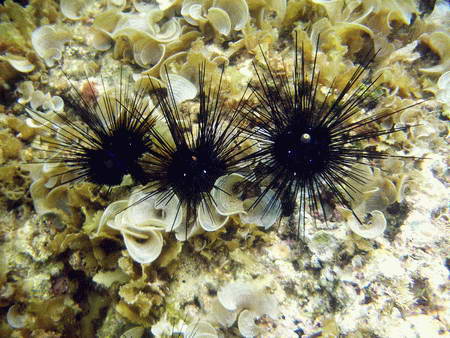
Area : 2 (kelp intact)
Date: 30 May 2007
Notes: Just as area 2 has had the sides of its structures cleared of algae, so has this area as well. Although I did not note any urchins on the upper substrates which may, or may not, be due to the kelp being much taller and thicker. The population seems to have remained steady holding on average at least 15 individuals. Again, I have to assume that the structures available sheltering crevices and caves dictates how many urchins it will hold. I have to rule out food supply as a controlling factor as there is a great abundance of such foods available. I do have hopes that this areas population will start to clear the upper substrates as did the area one population.
Area : 1 (kelp removed)
Date: 17 June 2007
Notes: I was pleasantly surprised to see clear cut paths criss crossing the top of this area, leaving behind clean substrate. Obviously the sea urchins, having cleared the sides of the area, have found fresh grazing grounds as I had hoped they would.
With the tide being at its highest, I was unable to remain at depth while holding my breath long enough to get an accurate population count. The tidal movement also made the lengthy swim quite a work out, but well worth the effort to see some progress being made.
Area : 2 (kelp intact)
Date: 17 June 2007
Notes: No real changes noted for this area. The kelp still remains fully covering the top substrate yet the sides are being kept cleared. This was to be expected as there is a great deal more kelp for the resident sea urchins and will take them much longer to start making any progress in removing the kelp cover. Again, the water depth prevented me from making a population count.
Area : 1 (kelp removed)
Date: 19 July 2007
Notes: Made the swim out to the site today and again was very pleased to see the kelp being kept in check, at least in this area that is. Being high tide and not on scuba gear, I was not able to accurately count the sea urchins and could only see about a dozen that were obvious enough in the limited time I had while breath hold diving . The Padila algae seems to be replacing the kelp on top of the substrates which I am hoping is only a temporary adjustment and will also be kept in check soon.
Area : 2 (kelp intact)
Date: 19 July 2007
Notes: This area continues to worry me as it seems the sea urchins have yet to make any inroads on the top of the rock substrates. This again may be simply due to the fact that having not been cleared, the sea urchins have a great deal more to do. Again, I was unable to make an accurate head count today.
Area : 1 (kelp removed)
Date: 10 September 2007
Notes: My optimism in July appears to have been nothing more than that as the kelp is making a full comeback on top of the once cleared substrate. Of the thirty translocated sea urchins, I was able to count five remaining adult sized urchins within their daytime sheltering locations within the site.
After a survey of the surrounding area, I was unable to locate any sea urchin concentrations that would lead me to believe there had been a mass exodus from the site. Most likely, they wandered off as individuals or very small groups in search of daytime shelter.
With the great abundance of food algae present, I can only assume that shelter takes precedence over having a local food supply. It also appears that any substrate formations that has suitable shelter for at least three to five adult urchins per ten square feet has its vertical sides kept clear of all algae growth while the top of the formations become overgrown with kelp. Just as is happening within this study site.
Having spent more time in the nearby deeper area, I believe I will have to concede this study site to the kelp. It may be that the shallower zones that average five to fifteen feet deep prior to the coral dominated areas are best suited for the kelp and any control of it would require far more herbivore species than just the one sea urchin species that due to its sheltering needs only manage partial control.
I will continue to monitor this site for the next six months while I consider introducing another sea urchin species in the hopes that the combination of the two species will affect a better result in the control of kelp.
Area : 2 (kelp intact)
Date: 10 September 2007
Notes: Just as site 1, there appears to be no inroads made in controlling the kelp on top of the substrate, with only the vertical sides being kept clear of kelp growth. As with site 1, all but a few adult sized sea urchins appear to have found suitable shelter within this site with all other translocated urchins having moved off elsewhere.
22 October 2007
Both study sites now appear identical as the kelp has completely over grown the top of the substrates. Over the last few months as noted above, it has become very apparent that daytime shelter availability is the deciding factor on Diadema species population densities. With as rapid as growth that this kelp species has, any resident sea urchins have no reason to risk venturing on top of the substrates out in the open and can find all of their needs by remaining on the sides of the structures and close to shelter. Thankfully they at least keep the vertical sides of any structures clear of all algae growth which allows for a few coral species to settle upon. This concludes this study.
References:
- F.Tuya, J.A. Martin, G.M. Reuss, A. Luque, J. Mar. Biol. Ass. U.K. (2001), 81, 845-849, Food preferences of the sea urchin Diadema antillarum in Gran Canaria (Canary islands, central-east Atlantic ocean).
- Peter J. Edmunds; Robert C. Carpenter, Proceedings of the National Academy of Sciences of the United States of America, Vol. 98, No. 9.
(Apr. 24, 2001), pp. 5067-5071, Recovery of Diadema antillarum Reduces Macroalgal Cover and Increases Abundance of Juvenile Corals on a Caribbean Reef
- Mark E. Hay; William Fenical; Kirk Gustafson, Ecology, Vol. 68, No. 6. (Dec., 1987), pp. 1581-1591, Chemical Defense Against Diverse Coral-Reef Herbivores.
- Douglas Morrison, Ecology, Vol. 69, No. 5. (Oct., 1988), pp. 1367-1382, Comparing Fish and Urchin Grazing in Shallow and Deeper Coral Reef Algal Communities.
- F. Tuya, L. Ortega-Borges, A.B. Del Rosario-Pinilla and R.J. Haroun, J. Mar. Biol. Ass. U.K. (2006), 86, 791-797, Spatio-temporal variability in a key herbivore, the long-spined black sea urchin (Diadema antillarum, Echinodermata: Echinoidea) in the Canary Islands.
- Robert L. Vadas, Ecological Monographs, Vol. 47, No. 4. (Autumn, 1977), pp. 337-371. Preferential Feeding: An Optimization Strategy in Sea Urchins.
The majority of the Philippine fringing reefs having gone from coral dominated to algae dominated systems. This is likely due to having herbivore populations greatly reduced due to their being collected as a human food source by over fishing. This leaves the undesirable, or inedible Diadema setosum remaining as the dominant herbivore. While the near shore habitats contain and hold a large population of juvenile Diadema species, the outer reef areas contain few adults. Such areas are under threat by Sargassum kelp which precludes coral recruitment and growth. This study will explore the feasibility and ecological results of translocating juvenile Diadema setosum from areas with relatively high settlement to nearby deeper water on fringing reefs. This is an individual effort performed by Charles Raabe with inspiration and guidance provided by Eric Borneman.
Objective(s):
The objective of this study is to increase the survival and local breeding population of Diadema setosum by removing vulnerable juveniles from their near shore habitats out into deeper water. With other herbivore populations having been artificially reduced by human activities, the naturally occurring movement of Diadema setosum to deeper water has not allowed large enough populations able to keep up with the algae control once performed by other herbivores. It is hoped that by translocating juveniles into the areas in need, the algae can be kept under control while allowing a greater number of juveniles to reach spawning age and accelerate the necessary population growth.
Methodology:
A kelp dominated rocky area located in deeper water will be selected to encompass a ten square meter area. All kelp cover will be removed. Once this area is cleared, thirty Diadema juveniles will be translocated and monitored on a weekly basis. In addition, another nearby ten square meter area will be selected and allowed to remain kelp covered and have the same number of Diadema juveniles placed within it. Each area will contain the necessary topographical complexity to provide shelter and reduce predation as well as being surrounded by sand or other barriers to impede migration out of the selected areas.
Evaluation:
On a weekly basis, both areas will be given a cursory inspection to note any possible problems. On a monthly basis, a detailed survey will be taken to count individual specimens within each area as well as documenting the effectiveness of each population. Each evaluation will try to include photographs to document any changes noted.
Study Areas:
Located on the eastern shore of Mactan Island, The Philippines. A fringing reef habitat containing extensive sea grass beds and shallow rock rubble, algae dominated areas, average depth is two meters. Beyond lays the coral fringing reef at an average depth of five meters.

Survey Results:
Area 1 - Kelp removed prior to the placement of thirty juvenile specimens.
Area 2 - Kelp left intact prior to the placement of thirty juvenile specimens.
Photographic details to provide a before and after view of each area, with close up photographs to document any remaining algae as well as the overall habitat.
Note: Both sites are within ten meters of each other.
Area : 1 (kelp removed)
Date: 26 March 2007
Notes: Site selection prior to kelp removal.
Photographs:

Area : 2 (kelp intact)
Date: 26 March 2007
Notes: Site selection
Photographs:

Area : 1 (kelp removed)
Date: 28 March 2007
Notes: Partial clearance of site and placement of 30 juvenile Diadema setosum, which were translocated from a nearby shallow sea grass bed. Individuals averaged 17cm in circumference.
Photographs:

Area : 1 (kelp removed)
Date: 31 March 2007
Notes: Completed the removal of the remaining kelp. A population count was performed. Of the original thirty placed on 28 March. Fifteen remain within two feet of their original placement point and have moved as a group, to this areas highest point. Ten others remained within inches of their original placement. I found that five members of the original population had moved out of the study area onto a meter squared rock which is located midway between the two study areas, which were then recollected and returned to their original starting point within the study area. An inspection of the area that the main population had moved to revealed that they do appear to be cleaning that areas substrate of all algae matter, including the corallines.
Photographs:

Area : 2 (kelp intact)
Date: 31 March 2007
Notes: Placement of 30 juvenile Diadema setosum. A single specimen of another species was found in the study site and does not appear to be eating the kelp.
Photographs:

Area : 1 (kelp removed)
Date: 02 April 2007
Notes: Two groups of five urchins have left the site area and were found two meters away on much smaller isolated rocks. The remaining urchins (20) were found within sheltered areas either directly under the rock which forms a cave or they have taken shelter in suitably sized crevices. At this time I do have a concern if the remaining urchins will wander off the site as well. There appears to be a preference when moving, to do so in small groups. The availability of daytime shelter within a given area may determine local population densitys as such shelter seems to be the primary requirement.
Photographs:

Area : 2 (kelp intact)
Date: 02 April 2007
Notes: Half of the initial group has remained in the same location that they were initialy placed into. The other half have taken shelter within the sites crevices. They have also shown to be willing to consume the kelp as per the below photo.
Photographs:

Area : 1 (kelp removed)
Date: 15 April 2007
Notes: Performed a survey today looking for any changes or sea urchin movement from the study site. Of the thirty placed within the site, I was able to locate 24 individuals. None of which were found on the top of the site area. Which I had expected, as the sea urchins take shelter during the daylight.
Photographs:

Area : 2 (kelp intact)
Date: 15 April 2007
Notes: Of the thirty placed within the site, I counted 32 individuals. I assume a few sea urchins from the other nearby site relocated. Again, all individuals were found in sheltered areas of the site. To date, I have good expectations, as the sea urchins do appear to be clearing all algae, including the kelp, from the immediate areas of their daytime shelter. I noted that the sea urchins, when originaly placed on the top of the site, have cleared the initial placement area of kelp and created a kelp free path as they made their way to more sheltered locations within the site.
Photographs:

Area : 1 (kelp removed)
Date: 26 April 2007
Notes: As I had suspected, it appears that shelter is of great importance to the sea urchins as they appear to have spaced themselves out according to available crevices in which to take daytime shelter within. Each sea urchin appears to have staked out a specific sheltering location which it ventures out from at night to feed, eating the closest available algae and working its way outwards as it consumes its food sources nearest its shelter. I expect to see population densities thin out as the sea urchins consume readily available algae and are forced to spread themselves out amongst the habitat. As such, I will have to enlarge the study area to observe and document what the final densities become per available shelter and food sources.
Area : 2 (kelp intact)
Date: 26 April 2007
Notes: As noted earlier this month, the sea urchins appear to concentrating their grazing in the area nearest their daytime sheltering locations, which are located nearest the sea floor or under any overhanging ledges. These areas of course get grazed first. As the sea urchins deplete the nearest food sources, it is my hope that they will then venture onto the top most surface areas that recieve the most daylight and clear those areas, allowing coral recruitment to occur. In due time, I hope to be able to answer the question of wether hunger or safety will be the deciding factor in wether the upper substrates are cleared of algae or not.
Area : 1 (kelp removed)
Date: 10 May 2007
Notes: Since March 28th, those sea urchins that have remained within the study site have grown from an average cirumference of 17cm to over 30cm. As of today, I could only locate 12 of the original group noting the remainder have moved off of the study site into very nearby smaller rocky substrates, again, I have to assume that daytime shelter takes precedence over very nearby food sources. I also noted what appears to be some new coral growth, although I am unable to determine if this particular coral was already present and is just responding to the newly available light or if it had settled onto the newly algae free substrate recently.
Photographs:

Area : 2 (kelp intact)
Date: 10 May 2007
Notes: I was able to count only 16 of the original 30 placed within this area but continue to note an improvement in the reduction of the kelp cover. Just as Site 1, it appears that almost half of the originaly placed group has moved off of the site into nearby rocky shelters. Seeing that there is an overabundance of food sources, I can only conclude that available shelter will determine the final population densities. As such, I will have to continue to monitor the remaining population as to their ability to reduce and then control the invasive kelp.
Area : 1 (kelp removed)
Date: 30 May 2007
Notes: The weather cleared enough today to allow me back into the ocean. For the last three weeks, the passing storms have kept the surface water rough enough that I would not risk the lengthy swim out to the study site. It is at times like this that having a small boat and scuba gear available would come in handy. Today I noted that the remaining kelp stalks that were left behind when I initialy cleared this site have sprouted up again and have done so quite quickly, as has a padila species of macro algae.
I was also surprised to see a few small groups of urchins moving about the surface of the structure. This is the first time I have seen them out in the open during daylight. They also appear to remain close together in small groups when grazing in such a manner and I have to assume they do so as a means for protection. The more spines the better. I was also glad to note that the sides of the structure are now clear of all algae which might explain finding a few urchins on the upper surfaces now. Hopefully this is a trend that will continue.
Photographs:

Area : 2 (kelp intact)
Date: 30 May 2007
Notes: Just as area 2 has had the sides of its structures cleared of algae, so has this area as well. Although I did not note any urchins on the upper substrates which may, or may not, be due to the kelp being much taller and thicker. The population seems to have remained steady holding on average at least 15 individuals. Again, I have to assume that the structures available sheltering crevices and caves dictates how many urchins it will hold. I have to rule out food supply as a controlling factor as there is a great abundance of such foods available. I do have hopes that this areas population will start to clear the upper substrates as did the area one population.
Area : 1 (kelp removed)
Date: 17 June 2007
Notes: I was pleasantly surprised to see clear cut paths criss crossing the top of this area, leaving behind clean substrate. Obviously the sea urchins, having cleared the sides of the area, have found fresh grazing grounds as I had hoped they would.
With the tide being at its highest, I was unable to remain at depth while holding my breath long enough to get an accurate population count. The tidal movement also made the lengthy swim quite a work out, but well worth the effort to see some progress being made.
Area : 2 (kelp intact)
Date: 17 June 2007
Notes: No real changes noted for this area. The kelp still remains fully covering the top substrate yet the sides are being kept cleared. This was to be expected as there is a great deal more kelp for the resident sea urchins and will take them much longer to start making any progress in removing the kelp cover. Again, the water depth prevented me from making a population count.
Area : 1 (kelp removed)
Date: 19 July 2007
Notes: Made the swim out to the site today and again was very pleased to see the kelp being kept in check, at least in this area that is. Being high tide and not on scuba gear, I was not able to accurately count the sea urchins and could only see about a dozen that were obvious enough in the limited time I had while breath hold diving . The Padila algae seems to be replacing the kelp on top of the substrates which I am hoping is only a temporary adjustment and will also be kept in check soon.
Area : 2 (kelp intact)
Date: 19 July 2007
Notes: This area continues to worry me as it seems the sea urchins have yet to make any inroads on the top of the rock substrates. This again may be simply due to the fact that having not been cleared, the sea urchins have a great deal more to do. Again, I was unable to make an accurate head count today.
Area : 1 (kelp removed)
Date: 10 September 2007
Notes: My optimism in July appears to have been nothing more than that as the kelp is making a full comeback on top of the once cleared substrate. Of the thirty translocated sea urchins, I was able to count five remaining adult sized urchins within their daytime sheltering locations within the site.
After a survey of the surrounding area, I was unable to locate any sea urchin concentrations that would lead me to believe there had been a mass exodus from the site. Most likely, they wandered off as individuals or very small groups in search of daytime shelter.
With the great abundance of food algae present, I can only assume that shelter takes precedence over having a local food supply. It also appears that any substrate formations that has suitable shelter for at least three to five adult urchins per ten square feet has its vertical sides kept clear of all algae growth while the top of the formations become overgrown with kelp. Just as is happening within this study site.
Having spent more time in the nearby deeper area, I believe I will have to concede this study site to the kelp. It may be that the shallower zones that average five to fifteen feet deep prior to the coral dominated areas are best suited for the kelp and any control of it would require far more herbivore species than just the one sea urchin species that due to its sheltering needs only manage partial control.
I will continue to monitor this site for the next six months while I consider introducing another sea urchin species in the hopes that the combination of the two species will affect a better result in the control of kelp.
Area : 2 (kelp intact)
Date: 10 September 2007
Notes: Just as site 1, there appears to be no inroads made in controlling the kelp on top of the substrate, with only the vertical sides being kept clear of kelp growth. As with site 1, all but a few adult sized sea urchins appear to have found suitable shelter within this site with all other translocated urchins having moved off elsewhere.
22 October 2007
Both study sites now appear identical as the kelp has completely over grown the top of the substrates. Over the last few months as noted above, it has become very apparent that daytime shelter availability is the deciding factor on Diadema species population densities. With as rapid as growth that this kelp species has, any resident sea urchins have no reason to risk venturing on top of the substrates out in the open and can find all of their needs by remaining on the sides of the structures and close to shelter. Thankfully they at least keep the vertical sides of any structures clear of all algae growth which allows for a few coral species to settle upon. This concludes this study.
References:
- F.Tuya, J.A. Martin, G.M. Reuss, A. Luque, J. Mar. Biol. Ass. U.K. (2001), 81, 845-849, Food preferences of the sea urchin Diadema antillarum in Gran Canaria (Canary islands, central-east Atlantic ocean).
- Peter J. Edmunds; Robert C. Carpenter, Proceedings of the National Academy of Sciences of the United States of America, Vol. 98, No. 9.
(Apr. 24, 2001), pp. 5067-5071, Recovery of Diadema antillarum Reduces Macroalgal Cover and Increases Abundance of Juvenile Corals on a Caribbean Reef
- Mark E. Hay; William Fenical; Kirk Gustafson, Ecology, Vol. 68, No. 6. (Dec., 1987), pp. 1581-1591, Chemical Defense Against Diverse Coral-Reef Herbivores.
- Douglas Morrison, Ecology, Vol. 69, No. 5. (Oct., 1988), pp. 1367-1382, Comparing Fish and Urchin Grazing in Shallow and Deeper Coral Reef Algal Communities.
- F. Tuya, L. Ortega-Borges, A.B. Del Rosario-Pinilla and R.J. Haroun, J. Mar. Biol. Ass. U.K. (2006), 86, 791-797, Spatio-temporal variability in a key herbivore, the long-spined black sea urchin (Diadema antillarum, Echinodermata: Echinoidea) in the Canary Islands.
- Robert L. Vadas, Ecological Monographs, Vol. 47, No. 4. (Autumn, 1977), pp. 337-371. Preferential Feeding: An Optimization Strategy in Sea Urchins.